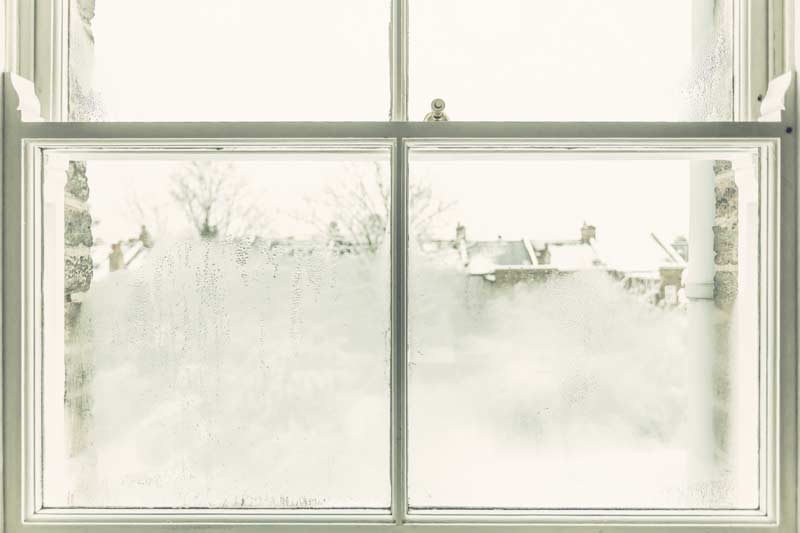Can’t see through your windows for moisture vapour?
Condensation can be a real problem in period properties or those which are too well sealed up. That’s because buildings need to breathe and let moisture out as well as keeping the heat in, but you don’t want to let much heat out in order to achieve that.
If you find yourself keeping your windows closed to keep your period property warm, but then having to clear up a puddle of water from the windowsill every morning, you’ll understand this issue all too well.
It’s practically impossible to eradicate condensation entirely because cooking, showers and even breathing put moisture into the air. However, provided your condensation problems are caused by internally generated moisture, CosyGlazing can significantly reduce condensation. Our experience has been that if customers have very heavy condensation as a result of moisture created internally, then CosyGlazing can reduce this to light condensation, and if they have light condensation from internal moisture sources, CosyGlazing will generally make it disappear completely.
It’s worth understanding a little about condensation to make sure you get the right solution though so read on.

There are three main causes of condensation
1) Moisture content in the window timbers
If you have had cracked or broken putty (even with fine hair line cracks) for some time, rain will have been running down the glass and soaking into the putty, particularly along the lower edges of the glass, and this will have soaked into the window timbers and glazing bars.
This moisture then creeps underneath the glass and comes out on the inside between the primary and secondary glazing, condensing on the inside of the glass and causing condensation to be trapped in the void. If the window timbers have already become saturated with water, then even if the windows are subsequently restored, moisture already in the wood will evaporate into the void and cause condensation. The only way to ascertain if the window timbers are saturated is to take readings with a moisture content detector. Perfect joinery-quality timber has a moisture content of around 12% and we have found that windows suffering from condensation can have moisture content as high as 30-40%.
One solution to saturated timbers is to paint the window frames inside the void between the glass and the magnetic strips with a waterproof yacht primer. This prevents moisture evaporating into the void. However, the rest of the window frame is still painted with normal paint which is micro-porous and allows the timber to breathe.
2) Background humidity levels of the house
Every house will vary, even two houses next door to each other, because the ground underneath the house will have different moisture content in different places, with spring-like activity occurring in the soil beneath the house. Saturated ground and moisture ingresses particularly, are strong where a property is below a hill or the outside ground level is higher than the floor level on any of the walls.
3) Low ventilation levels
Other factors that contribute to moisture in the house are low ventilation levels. Larger rooms have more capacity to absorb the moisture created by cooking, washing and laundry (drying laundry in the house emits 2-3 litres of water per load, so drying laundry in the house significantly raises the humidity levels of the house).
To reduce humidity levels and ventilate the house regularly, consider damp proofing measures such as injected damp proof coarse or tanking floors. Also consider drying laundry outside if possible and opening the windows while cooking and bathing. In particular, throw open all the windows for a couple of hours on dry days.
MVHR (Mechanical Ventilation Heat Recovery)
This is an electronic system that mimics the behaviour of Victorian houses.
In the Victorian era most homes had fireplaces in every room, coal was relatively abundant and roaring fires in every room sucked air in through draughty doors and windows and pushed it up the chimney, so the house had a high rate of air changes per hour. In the 20th century we sealed up all the draughts from the doors and windows, sealed up the chimneys and put in central heating, which does not ventilate the rooms at all. We also spent more time indoors and our breathing further humidifies the air.
MVHR consists of a box in the loft with a fan in it, with pipes running to the kitchen and bathroom. The fan in it costs around £50 a year to run. The system extracts air from the wet rooms, kitchens and bathrooms, pumps it out under the eaves and sucks in new air (external air is almost always drier than internal air except in the wettest weather). The system then sucks in fresh air from the outside and pumps it in at the top of the stairwell from where it finds its way into all the rooms. The system also extracts 90 per cent of the heat from the air that is going out and puts it back into the air going in. The effect is to mimic the number of air changes created by Victorian fireplaces without losing any of the heat. This creates an atmosphere in the house which is fresher, drier and much easier to heat and will significantly reduce condensation on walls and windows in damp properties.
Talk to us about how we can help you reduce condensation in your home.
